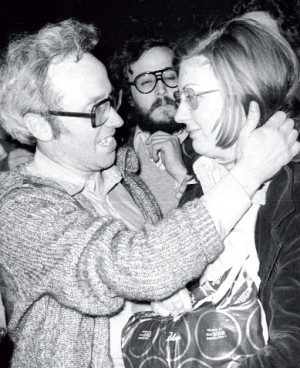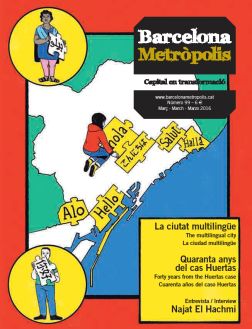Huertas was librarian at la Model. He was impacted by the memory of lending a book to Txiki, the day before he became the last person to be executed by Franco.

Josep Maria Huertas and his wife and lawyer Araceli Aiguaviva are reunited outside of la Model.
Photo: Huertas family archives.
Many years have passed since Josep Maria’s imprisonment, and my memory is hazy. But I will try to sum up some of what I can remember with relative clarity.
We were lucky to have Agustí de Semir and his wife Conxa. Agustí was a father, friend, counsel, strategist and an expert on the ways of the Franco regime, because he had been a soldier. When he left the army he became a great fighter for human rights, together with Conxa. I used to meet with them every morning. They were often accompanied by Josep Maria Prochazka, then chairman of the Poblenou residents’ association. Although Josep Maria’s official lawyer was the Press Association’s criminal lawyer Octavio Pérez Vitoria, we went to all kinds of lengths and organised all sorts of contacts to get his defence on track, not only legally but especially on a personal scale, to keep him from getting bogged down by everything and to work with the citizen and journalistic movement that materialised.
The biggest shock was when a Francoist newspaper published a news item, which was reproduced on television, with a headline that said “Four nuns and Huertas Clavería – the Barcelona contacts of Carrero Blanco’s killer”. One of the decisions we then made was that I would publish a letter in the media to explain the reality, which was only having fed a guy who came from the Basque Country and who was looking for somewhere to stay. The letter tore down the Franco regime’s propagandist and opportunist plot by means of which it was trying to link Josep Maria to the Basque separatist group ETA.
I was able to register as his second lawyer. This allowed me to visit him at the prison every day. No physical contact was allowed during visits. We always saw each other through a window with iron bars and a plastic barrier with holes that was dirty and scratched and had a very unpleasant smell.
Starting in October he shared his cell with the doctor Jordi Roca and an ex-monk from Montserrat, Quico Bofill. Every day I brought them lunch from Bar Modelo, located opposite the prison, and the three of them would share it. I remember the couple who ran the bar very well. They were very progressive, pleasant, and it’s worth saying that they cooked very well and generously. We saw each other several times after Josep Maria left the prison.
There was only one time that Josep Maria wanted our son Guillem – who was about to turn two – to come to La Model to visit him. He didn’t want it to happen again because it was too painful. They didn’t let me come in with the child. A nun accompanied him to the designated place where he could see his father.
It was very important to him that the “master” of the prison let him be the librarian. This enabled him to spend lots of time organising the library and handing out books to the prisoners. He explained to me how the day he took books to the ETA militant Txiki had an impact on him: Txiki took one entitled Te veré en el infierno [See you in hell] and told Josep Maria he didn’t need anything else. He was executed the next day.
The other chance to stay active was to get permission to work on Tots els barris de Barcelona. With him inside the prison, Jaume [Fabre] outside and me looking for all the material that Josep Maria was asking me for, we made a very effective team. I went in and brought all the material that went from Josep Maria to Jaume and vice versa: books, galley proofs, notes, clippings, newspapers, etc., always within the bounds of the permitted channels.



